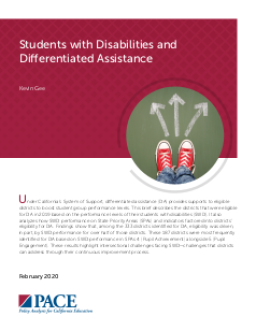Summary
Summary
Summary
Summary
Summary
This report updates previous research on California's Local Control Funding Formula (LCFF) using a 2019 poll of California voters. Despite increased awareness, over half of voters are unfamiliar with LCFF. Support for the policy remains high but has decreased. Participation in LCFF engagement has increased but remains low, particularly among low-income voters. Low-income communities may not be meaningfully engaged in LCFF decision-making.
Summary
This brief analyzes the 2018 update of the California School Dashboard, examining improvements and areas for continued enhancement. Using data from the 2019 PACE/USC Rossier poll, the author characterizes use of and support for the Dashboard, finding low use, equity gaps, but high support and preference for the new Dashboard.
Summary
Governor Newsom’s first Budget Proposal increases funding for education in California. There are areas of substantive overlap in the Budget Proposal and research findings from the Getting Down to Facts II (GDTFII) research project, released in September 2018, which built an evidence base on the current status of California education and implications for paths forward. As the Budget moves from proposal to reality, it is critical that the evidence from GDTFII continues to inform the policy process.
Summary
California's Local Control Funding Formula highlights low performance of special education students. Many districts allocate more base funding for all students into special education. A study found state funding growth has not kept pace with district costs, and the current formula inadequately funds preschool programs for infants and toddlers with disabilities. The study suggests better alignment between special education and the LCFF, and improved governance and accountability structures.
Summary
Charter schools serve 620,000 students in California, but their impact on traditional public schools is unknown. Charter schools have significantly better academic growth in urban areas and lower-performing groups. California's charter school authorization is decentralized with limited accountability and oversight capacity. Renewal processes are unclear, and the standards for renewal are low.
Summary
California's implementation of Common Core State Standards and Local Control Funding Formula requires new support systems for districts, including professional networks and the California Department of Education. Successful implementation requires multiagency cooperation and strategic management of relations with Washington.
Summary
California's Local Control Funding Formula (LCFF) has increased per-pupil revenues, especially for low-income districts, and provided more flexibility in expenditures, leading to improvements in student outcomes. The funding was distributed based on the proportion of disadvantaged students, and expenditure increases were primarily allocated to teachers, pensions, and special education. The policy was implemented during a time of increased K-12 funding after the Great Recession and existing revenue distribution patterns.
Summary
California has implemented new academic standards for English, math, and science, and changed how school districts are funded and held accountable. Educators face challenges implementing these standards, requiring changes in teaching, learning, and instructional materials. Teachers need professional development, improved instructional support, and collaborative learning opportunities. School principals play a key role in implementation and depend on district support. Despite positive perceptions, progress requires staying the course to let the standards take root.
Summary
The Local Control Funding Formula (LCFF) shifts control of education dollars to local districts, enhancing resource allocation practices. However, inadequate base funds may constrain progress. Stakeholder engagement is evolving yet remains challenging, and school board involvement is typically modest. LCFF communication and accountability mechanisms receive mixed reviews. County offices of education have expanded their role but will need to increase their capacity. Public awareness of the LCFF lags, but it enjoys substantial support.
Summary
California and the US are undergoing a cultural shift in school accountability policies towards locally-determined measures of school performance. Lessons can be learned from the CORE districts, which developed an innovative accountability system, emphasizing support over sanctions, and utilizing multiple measures of school quality. The CORE districts' measurement system and collaboration hold promise for improving local systems, but efforts to build capacity remain a work in progress.
Summary
The Local Control Funding Formula (LCFF) replaced categorical funding for schools in California in 2013, providing flexibility, targeted student funding, and local accountability. Two years in, research shows optimism and concern. The Local Control and Accountability Plan (LCAP) faces challenges, stakeholders need more engagement, and implementation requires capacity and overcoming the emerging teacher shortage. Public awareness of LCFF lags at 65%.
Summary
Summary
Summary
Summary
Common Core State Standards (CCSS) will impact many state education policies in fundamental ways. Before 1990, most states did not have uniform K-12 academic standards, and each state developed its own. To align policies with CCSS, CA must eliminate contradictions, look for gaps where no policy exists, and ensure sufficient breadth and depth of newly aligned policies. Common Core will transform instruction by focusing on fewer, higher, and deeper standards. However, current state assessment and accountability systems in CA are not aligned with the CCSS's specific instructional approach.
























